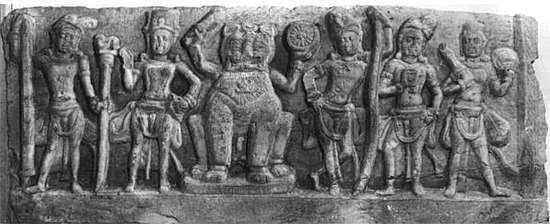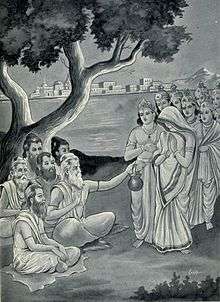Samba (Krishna's son)
Samba (Sanskrit: साम्ब sāmba) was a son of Vāsudeva-Krishna, the Hindu god, and Jambavati. His half-brother was Pradyumna.[1] His actions, caused by anger, brought an end to the Yadu dynasty.His wife is lakshmanaa(the daughter of Duryodhana).[2]
| Samba | |
|---|---|
 Samba, holding a cup, in the Kondamotu Vrishni heroes relief, 4th century CE |
| Vrishni heroes |
|---|
 |
In the 1st century BC, there seems to be evidence for a worship of five Vrishni heroes (Balarama, Krishna, Pradyumna, Aniruddha and Samba), due to the Mora Well Inscription found at Mora near Mathura, which apparently mentions a son of the great satrap Rajuvula, probably the satrap Sodasa, and an image of Vrishni, "probably Vasudeva, and of the "Five Warriors".[3] The Brahmi inscription can be seen on the Mora stone slab, now in the Mathura Museum.[4][5]
Birth

The Mahabharata and the Devi Bhagavata Purana narrate the story of the birth of Samba. Jambavati was unhappy when she realized that only she had not born any children to Krishna while all other wives were blessed with many children. She approached Krishna to find a solution and to be blessed with a son like the handsome Pradyumna, Krishna's first-born son. Then Krishna went to the hermitage of the sage Upamanyu in the Himalayas and as advised by the sage, he started to pray to the god Shiva. He did penance for six months in various postures; once holding a skull and a rod, then standing on one leg only in the next month and surviving on water only, during the third month he did penance standing on his toes and living on air only. Pleased with the austerities, Shiva finally appeared before Krishna as Samba, (Ardhanarishvara) the half-female, half-male form of the god, asked him to ask a boon. Krishna then sought a son from Jambavati, which was granted. A son was born soon thereafter who was named as Samba, the form Shiva had appeared before Krishna.[6][7] Samba looked exactly like Lord Krishna and Lord Krishna taught him all his leelas and became notorious and naughty like Krishna's younger days. Later Samba played an instrumental role in the destruction of Yadu dynasty. The main reason behind Samba that he became responsible for the destruction of Yaduvansh was that when Lord Krishna asked for the boon from Shiva than lord replied that the from Jambavati would be one of eleven rudra of shiva who are meant for destruction and so the Samba, Lord Krishna accepted that.
According to Bhagavata Purana, Jambavati was the mother of Samba, Sumitra, Purujit, Shatajit, Sahasrajit, Vijaya, Chitraketu, Vasuman, Dravida and Kratu.[8] The Vishnu Purana says that she has many sons headed by Samba.
Marriage
Samba grew up to be a nuisance to the Yadavas, Krishna's clan. Lakshmanaa, who was the daughter of Duryodhana and younger sister of Laxman Kumara had come of age.[9] Her father arranged her swayamvara and many princes came to win her hand. Samba had heard of Lakshmana and wanted to marry her, although she was not inclined to him. He went to her swayamvara and abducted her forcefully. He defeated the Kuru maharathi's who pursued him but was finally caught. He was arrested by the Kuru elders and thrown in prison.
Lakshmanaa's swayamvara was re-arranged but no other prince was willing to marry her, since it was considered that a woman abducted by another man belonged to that man, although the other princes were actually afraid of the Yadavas who might attack them on Samba's behalf. Balarama, who was fond of his notorious nephew went to Hastinapur to bail him out. The Kurus refused. Balarama became enraged and started smashing up the palace. Soon after, Duryodhana apologized for their conduct. Balarama was pacified and ordered the Kurus to free Samba. Duryodhana then affectionately married his daughter off to Samba and the marriage was celebrated in pomp and show.
Curse of Leprosy
The Samba Purana consists the narrative of Samba's getting infected by leprosy, after being cursed by sage Durvasa for mocking him. Later, he got cured by worshipping Surya in the temple constructed by him in Mitravana on the banks of the Chandrabhaga, which was once Multan Sun Temple.[10] Samba underwent penance for 12 years in Mitravana near the shores of Chandrabhaga.[11] Both the original Konark Sun Temple and the Multan Sun Temple[12] at Multan, earlier known as Kashyapapura, have been attributed to Samba. He was cured by the Sun God Surya after 12 years of penance near Konark. As a tradition in the state of Odisha, India this day is celebrated as Samba Dashami on the 10th day of the Shukla Paksha of Pausha Masa. On this day, mothers pray to Surya for the health of their children.
The Bhavishya Purana, the Skanda Purana and the Varaha Purana narrate that some of Krishna's junior wives were infatuated with Samba. One wife Nandini disguised herself as Samba's wife and embraced him. For this incest, Krishna cursed Samba to be inflicted with leprosy and his wives to be kidnapped by robbers after his death.[13][14]
Destruction of the Yadava clan

At the end of Kurukshetra war, all 100 of Gandhari's sons, the Kauravas were killed by their cousins, the Pandavas, who were aided by Krishna. Pandavas also lost all of their sons. Gandhari cursed Krishna for allowing all this destruction to happen. She cursed that he, his city and all his subjects would be destroyed. Krishna accepted the curse.[15][16]
The book Mausala Parva describes the fulfillment of the curse 36 years after the end of the great war. The empire is peaceful and prosperous, the youth of Yadavas have become frivolous and hedonistic. Samba dresses up as a woman and his friends meet Rishi Vishwamitra, Durvasa, Vashista, Narada and other rishis, who were visiting Dwaraka for an audience with Krishna. The young man playfully pretending to be a woman claims he is pregnant, and asks the rishis to predict the gender of the baby. One Rishi sees through the prank. In a fit of rage, he curses Samba will give birth to an iron bolt (Gada (mace) a weapon) that will destroy his entire race. As per the curse, Samba next day delivered an iron rod. The youth inform King Ugrasena what has happened, who asks Samba to powder the iron bolt and cast it into the Prabhas sea. Later this powder grew up on sea shore in the form of eraká grass. After some time a fight with iron clubs made of eraká grass, broke out between the Yadavas, at a festival, who killed each other, thus ending up the whole of the clan. A piece to the same iron bolt dropped down in the sea and swallowed by a fish which was caught by a hunter named Jara. He took out the iron piece and applied it on the tip of his arrow. The hunter Jara, mistook Krishna's partly visible left foot for that of a deer, and shot an arrow, wounding him mortally resulting departure of Krishna from the earth.
References
Notes
- Hudson (2008), p. 417
- Hudson (2008), p. 101
- Barnett, Lionel David (1922). Hindu Gods and Heroes: Studies in the History of the Religion of India. J. Murray. p. 93.
- Puri, B.N. (1968). India in the Time of Patanjali. Bhartiya Vidya Bhavan.Page 51: The coins of Raj uvula have been recovered from the Sultanpur District.. the Brahmi inscription on the Mora stone slab, now in the Mathura Museum,
- Barnett, Lionel David (1922). Hindu Gods and Heroes: Studies in the History of the Religion of India. J. Murray. p. 92.
- Swami Parmeshwaranand (2004). Encyclopaedia of the Śaivism. Sarup & Sons. p. 62. ISBN 978-81-7625-427-4.
- Vettam Mani (1975). Puranic Encyclopaedia: a Comprehensive Dictionary with Special Reference to the Epic and Puranic Literature. Motilal Banarsidass Publishers. pp. 342, 677. ISBN 978-0-8426-0822-0.
- Bhgavata Purana. Vedabase.net. Retrieved on 2013-05-02.
- "Krishna Book Chapter 67: The Marriage of Samba". Krsnabook.com. Retrieved 26 August 2012.
- Dowson, John. A Classical Dictionary of Hindu Mythology and Religion, Geography, History and Literature. Routledge. pp. 276–77. ISBN 9781136390296. Retrieved 29 April 2017.
- "Official website: The Sun Temple Legend". Tourism Department, Government of Orissa. Archived from the original on 31 December 2013. Retrieved 27 July 2013.
- Sir Alexander Cunningham (1871). The Ancient Geography of India: I. The Buddhist Period, Including the Campaigns of Alexander, and the Travels of Hwen-Thsang. Trübner & Company. p. 233. Retrieved 27 July 2013.
- Mani, Vettam (1975). Puranic Encyclopaedia: a Comprehensive Dictionary with Special Reference to the Epic and Puranic Literature. Motilal Banarsidass Publishers. p. 677. ISBN 978-0-8426-0822-0.
- Devdutt Pattanaik (1 September 2000). The Goddess in India: The Five Faces of the Eternal Feminine. Inner Traditions / Bear & Co. pp. 101–2. ISBN 978-0-89281-807-5. Retrieved 24 April 2013.
- Stri Parva The Mahabharata, Translated by Kisari Mohan Ganguli, Published by P.C. Roy (1889)
- Pattanaik, Devdutt. "Tears of Gandhari". Devdutt.
Bibliography
- Hudson, D. Dennis (2008), The Body of God : An Emperor's Palace for Krishna in Eighth-Century Kanchipuram, Oxford University Press, ISBN 978-0-199-70902-1